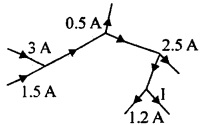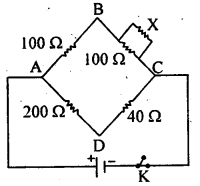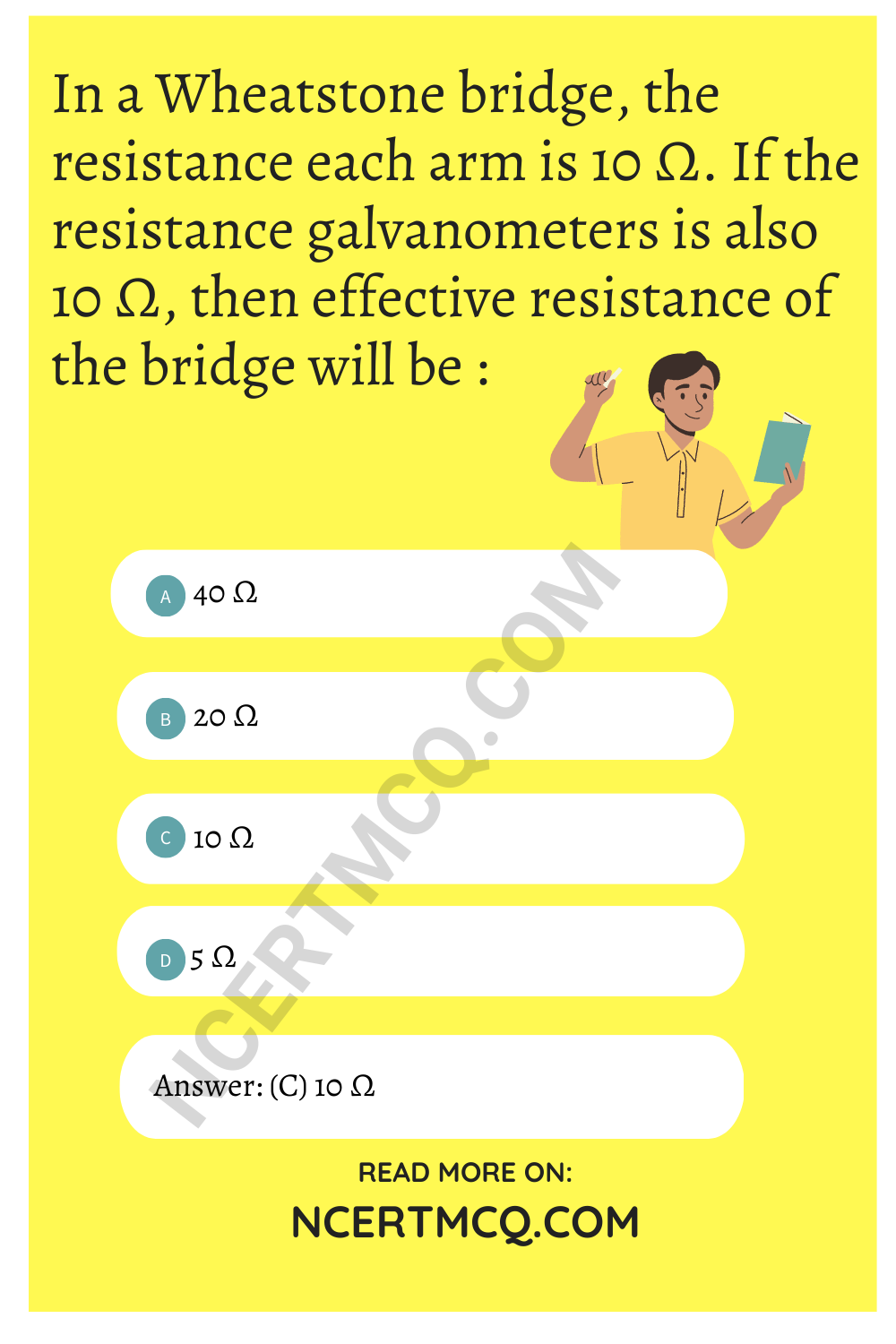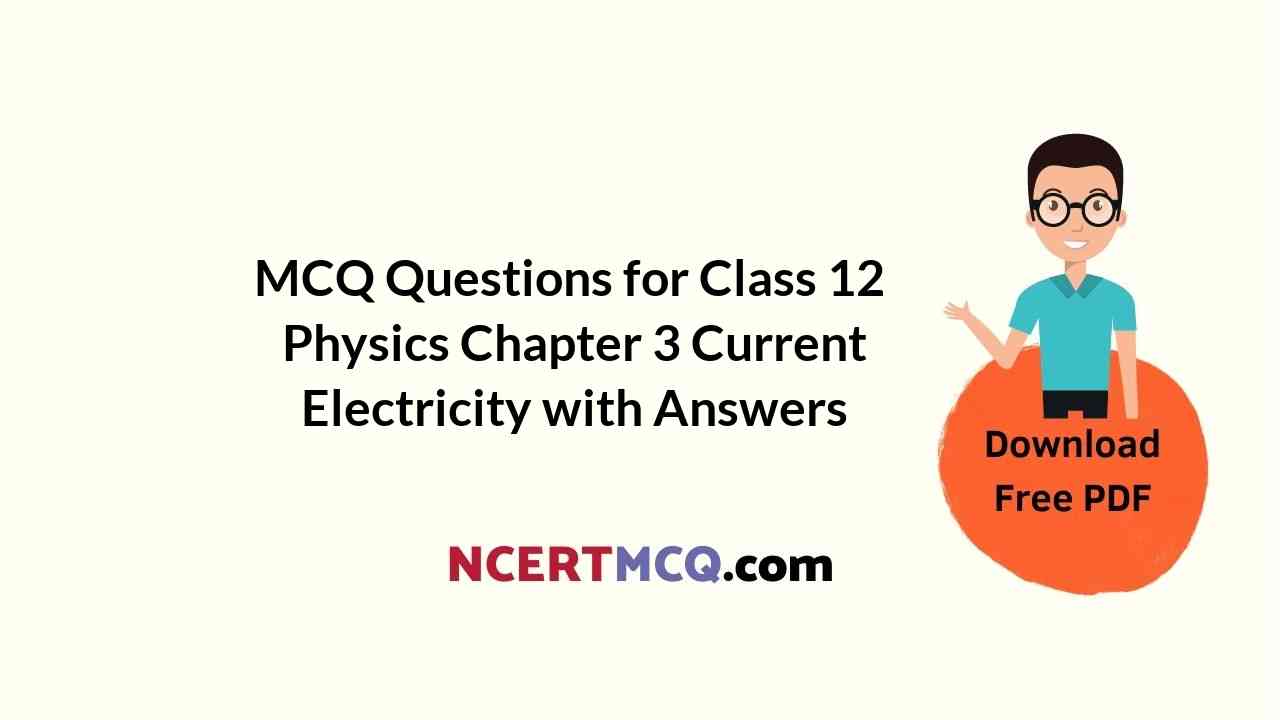Check the below NCERT MCQ Questions for Class 12 Physics Chapter 3 Current Electricity with Answers Pdf free download. MCQ Questions for Class 12 Physics with Answers were prepared based on the latest exam pattern. We have provided Current Electricity Class 12 Physics MCQs Questions with Answers to help students understand the concept very well.
Class 12 Physics Chapter 3 MCQ With Answers
Physics Class 12 Chapter 3 MCQs On Current Electricity
Current Electricity Class 12 MCQ Question 1.
The speed at which tjie current travels in a conductor is nearly:
(a) 3 × 104 ms-1
(b) 3 × 106 ms-1
(c) 3 × 108 ms-1
(d) 3 × 1010 ms-1
Answer
Answer: (a) 3 × 104 ms-1
Current Electricity MCQ Question 2.
The resistance of a human body is about:
(a) 12 Ω
(b) 120 Ω
(c) 12 KΩ
(d) 120 MΩ
Answer
Answer: (c) 12 KΩ
Class 12 Physics Chapter 3 MCQ Question 3.
The number of electrons that constitute 1 A of current is:
(a) 6.25 × 1016
(b) 6.25 × 1017
(c) 6.25 × 1018
(d) 6.25 × 1019
Answer
Answer: (c) 6.25 × 1018
MCQ On Current Electricity Question 4.
How many different resistances are possible with two equal resistors?
(a) 2
(b) 3
(c) 4
(d) 5
Answer
Answer: (b) 3
Chapter 3 Physics Class 12 MCQ Question 5.
Given three equal resistors, how many different combinations (taken all of them together) can be made?
(a) 3
(b) 4
(c) 5
(d) 6
Answer
Answer: (b) 4
Ch 3 Physics Class 12 MCQ Question 6.
Specific resistance of ali metals is mostly affected by:
(a) temperature
(b) pressure
(c) magnetic field
(d) volume
Answer
Answer: (a) temperature
MCQ Of Chapter 3 Physics Class 12 Question 7.
The example of a non-ohmic resistance is:
(a) copper wire
(b) fi lament lamp
(c) carbon resistor
(d) diode
Answer
Answer: (d) diode
Physics Class 12 Chapter 3 MCQ Question 8.
If a certain piece of copper is to be shaped into a conductor of minimum resistance, its length (L) and cross-sectional area (a) shall respectively be :
(a) L, 2A
(b) \(\frac{L}{2}\), 2A
(c) 2L, 2A
(d) 2l, \(\frac{A}{2}\)
Answer
Answer: (b) \(\frac{L}{2}\), 2A
Current Electricity Class 12 MCQ Questions And Answers Pdf Question 9.
The specific resistance of a rod of copper as compared to that of thin wire of copper is :
(a) less
(b) more
(c) same
(d) depends upon the length and area of cross-section of the wire
Answer
Answer: (c) same

Current Electricity MCQ Class 12 Question 10.
A wire of resistance 3 Ω is cut into three pieces, which are then joined to form a triangle. The equivalent resistance between any corners of the triangle is :
(a) \(\frac{2}{3}\) Ω
(b) \(\frac{3}{2}\) Ω
(c) \(\frac{1}{2}\) Ω
(d) \(\frac{1}{3}\) Ω
Answer
Answer: (a) \(\frac{2}{3}\) Ω
Class 12 Current Electricity MCQ Question 11.
The length of a conductor is halved. Its resistance will be :
(a) halved
(b) doubled
(c) unchanged
(d) quadrupled
Answer
Answer: (a) halved
MCQ Of Current Electricity Question 12.
In the above question, the conductance:
(a) halved
(b) doubled
(c) unchanged
(d) quadrupled
Answer
Answer: (b) doubled
MCQ On Current Electricity Class 12 Pdf Question 13.
Siemen is the unit of:
(a) resistance
(b) conductance
(c) specific conductance
(d) None of these
Answer
Answer: (b) conductance
MCQ Of Current Electricity Class 12 Question 14.
How much electric energy is consumed by a 100 W lamp used for 6 hours everyday for 30 days?
(a) 18 kJ
(b) 18 kWh
(c) 1.8 J
(d) None of these
Answer
Answer: (b) 18 kWh
MCQ On Current Electricity Class 12 Question 15.
Suppose H1 is the heat generated per second in the filament of a 100 W, 250 V lamp and H2 is the heat generated in the filament of a 200 W, 250 V lamp. Then H1/H2 is equal to:
(a) 1
(b) 2
(c) \(\frac{1}{2}\)
(d) \(\frac{1}{4}\)
Answer
Answer: (c) \(\frac{1}{2}\)
Question 16.
Two wires of copper are of the same length but’have different diameters. When they are connected in series across a battery, the heat generated is H1 When connected in parallel across the same battery, the heat generated during the same time is H2 Then :
(a) H1 = H2
(b) H1 < H2
(c) H1 > H2
(d) H1 > H2
Answer
Answer: (b) H1 < H2
Question 17.
In questions 135, w hen the wires are connected in series, the heat produced in the thinner wire is H1 and that in the thicker wire is H2. Then :
(a) H1 = H2
(b)H1 < H2
(c) H1 > H2
(d) H1 > H2
Answer
Answer: (c) H1 > H2
Question 18.
Kirchhoffs first and second laws for electrical circuits are consequences of:
(a) conservation of energy
(b) conservation of electrical charge and energy respectively
(c) conservation of electric charge
(d) neither conservation of energy nor electric charge
Answer
Answer: (b) conservation of electrical charge and energy respectively
Question 19.
A 5 A fuse wire can with stand a maximum power of 1 W in circuit. The resistance of the fuse wire is:
(a) 0.2 Ω
(b) 5 Ω
(c) 0.4 Ω
(d) 0.04 Ω
Answer
Answer: (d) 0.04 Ω
Question 20.
The length and radius of an electric resistance of a certain wire are doubled simultaneously, then the:
(a) resistance will be doubled and specific resistance will be halved
(b) resistance will be halved and specific resistance will remain uncharged
(c) resistance will be halved and the specific resistance will be doubled
(d) resistance and specific resistance will both remain uncharged
Answer
Answer: (b) resistance will be halved and specific resistance will remain uncharged
Question 21.
A galvanometer acting as a volt meter will have with its coil.
(a) a high resistance in parallel
(b) a high resistance in series
(c) a low resistance in parallel
(d) a low resistance in series
Answer
Answer: (b) a high resistance in series
Question 22.
When three identical bulbs of 60 W, 200 V rating are connected in series to a 200 V supply, the power drawn by them will be:
(a) 20 W
(b) 60 W
(c) 180 W
(d) 10 W
Answer
Answer: (a) 20 W
Question 23.
n resistances, each of R Ω, are connected in parallel gives an equivalent resistance of R Ω. If these resistances were , connected in series, the combination would have a resistance in Ω is equal to
(a) n²R
(b) R/n²
(c) R/n
(d) nR
Answer
Answer: (a) n²R
Question 24.
Why is the Wheatstone bridge more accurate than other methods of measuring resistances: ‘
(a) It is a null method
(b) It is based on Kirchhoffs laws
(c) It has four resistances
(d) It does not involve ohm’s law
Answer
Answer: (a) It is a null method
Question 25.
A potential difference of 10 V is applied across a conductance of 2 S. The current in the conductor will be :
(a) 20 A
(b) 5 A
(c) 0.2 A
(d) None of these
Answer
Answer: (a) 20 A
Question 26.
Ohm’s law is valid when the temperature of conductor is :
(a) very low
(b) very high
(c) varying
(d) constant
Answer
Answer: (d) constant
Question 27.
The emf of a car battery is about:
(a) 2.5 V
(b) 4.5 V
(c) 8.6 V
(d) 12 V
Answer
Answer: (d) 12 V
Question 28.
Emf is measured in :
(a) joule
(b) joule/coulomb
(c) joule-coulombs
(d) joule/coulomb/metre
Answer
Answer: (b) joule/coulomb
Question 29.
1 kilowatt hour is commonly known as :
(a) unit
(b) 1 faraday
(c) 1 curie
(d) None of these
Answer
Answer: (a) unit
Question 30.
How many joules are equal to I kWh ?
(a) 3.6 × 104
(b) 3.6 × 105
(c) 3.6 × 106
(d) None of these
Answer
Answer: (c) 3.6 × 106
Question 31.
The temperature coefficient of resistance is expressed in :
(a) °C
(b) °C-1
(c) m°C-1
(d) None of these
Answer
Answer: (b) °C-1
Question 32.
Copper wire is used as connecting wire because :
(a) copper has high electrical resistivity
(b) copper has low electrical resistivity
(c) copper has low electrical conductivity
(d) copper has high value of elasticity
Answer
Answer: (b) copper has low electrical resistivity
Question 33.
The heat sensitive device whose resistivity changes very rapidly with change of temperature is called a :
(a) resistor
(b) super-conductor
(c) thermocouple
(d) thermistor
Answer
Answer: (d) thermistor
Question 34.
The phenomenon of super-conductivity was discovered by :
(a) Ohm
(b) Onnes
(c) Edison
(d) None of these
Answer
Answer: (b) Onnes
Question 35.
The specific resistance of a conductor increases with :
(a) increase in temperature
(b) increase in cross-sectional area
(c) decrease in length
(d) decrease in cross-sectional area
Answer
Answer: (a) increase in temperature
Question 36.
In an experiment with potentiometer, null point with a cell is found at 240 cm. When the cell is shunted with a resistance 2 Ω, the null point becomes 120 cm internal resistance of cell is :
(a) 4 Ω
(b) 2 Ω
(c) 1 Ω
(d) \(\frac{1}{2}\) Ω
Answer
Answer: (b) 2Ω
Question 37.
Two conductors of equal length and radii the ratio of 2 : 3 are; connected in parallel the source of electricity. The ratio of the velocity of electrons in the conductor be :
(a) 2 : 3
(b) 4 : 9
(c) 1 : 1
(d) 3 : 2
Answer
Answer: (c) 1 : 1
Question 38.
The charge flowing in a conductor varies with time as :
q = αt \(\frac{1}{2}\) βt² + \(\frac{1}{6}\) γt³
Where α, β, γ are positive constants. Then the initial current (l) is given by the condition :
(a) l = α
(b) l = α²
(c) l = α-1
(d) None of these
Answer
Answer: (a) l = α
Question 39.
In questions 38, the maximum value of current (lmax) is given by the condition :
(a) lmax = α – \(\frac{β^2}{2γ}\)
(b) lmax = α – \(\frac{β^2}{2α}\)
(c) lmax = α – \(\frac{γ^2}{2β}\)
(d) None of these
Answer
Answer: (a) lmax = α – \(\frac{β^2}{2γ}\)
Question 40.
In questions 38, the line (t) after which the value of current reaches a maximum values given by :
(a) t = \(\frac{α}{β}\)
(b) t = \(\frac{β}{α}\)
(c) t = \(\frac{β}{γ}\)
(d) t = \(\frac{γ}{β}\)
Answer
Answer: (a) t = \(\frac{α}{β}\)
Question 41.
In following figure shows currents in a part of electrical circuit, then the value of/(in ampere) is given by :

(a) 0.3 A
(b) 0.5 A
(c) 1.3 A
(d) None of these
Answer
Answer: (a) 0.3 A
Question 42.
The smallest resistance that can be obtained by the combination of n resistors each resistance r is :
(a) \(\frac{r}{n}\)
(b) nr
(c) \(\frac{n}{r}\)
(d) n²r
Answer
Answer: (a) \(\frac{r}{n}\)
Question 43.
Which of the following has a negative temperature coefficient of resistance ?
(a) Tungsten
(b) Carbon
(c) Nichrome
(d) Platinum
Answer
Answer: (b) Carbon
Question 44.
An electric heating element consumes 500 W, when connected to a 100 V line. If the line voltage becomes 150 V, the power consumed Will be:
(a) 500 W
(b) 750 W
(c) 1000 W
(d) 1125 W
Answer
Answer: (b) 750 W
Question 45.
A uniform w ire connected across a supply produces heat H per second. If wire is cut into three equal parts and all the parts are connected in parallel across the same supply, the heat produced per second will be :
(a) \(\frac{H}{9}\)
(b) 9 H
(c) 3 H
(d) \(\frac{H}{3}\)
Answer
Answer: (d) \(\frac{H}{3}\)
Question 46.
In India electricity is supplied fordomestic use at 220 V. It is supplied at 110 V in U.S.A. If the resistance of a 60 W bulb use in India is R. the resistance of a 60 W bulb for use in USA will be:
(a) 2 R
(b) R
(c) R/2
(d) R/4
Answer
Answer: (d) R/4
Question 47.
In the following figure represents a balanced Wheatstone bridge circuit. What is the value of X ?

(a) 15 Ω
(b) 20 Ω
(c) 25 Ω
(d) 30 Ω
Answer
Answer: (c) 25 Ω
Question 48.
Two bulbs 25 W, 220 V and 100 W, 220 V are given. Which has higher resistance?
(a) 25 W
(b) 100 W
(c) both bulbs have equal resistance
(d) resistance of bulbs can not be compared
Answer
Answer: (a) 25 W
Question 49.
Potentiometer measures the potential difference more accurately than a voltmeter because:
(a) It has a wire of high resistance
(b) It has a wire of low resistance
(c) It does not draw current from external circuit
(d) It draws heavy current from external circuit
Answer
Answer: (c) It does not draw current from external circuit
Question 50.
In a Wheatstone bridge, the resistance each arm is 10 Ω. If the resistance galvanometers is also 10 Ω, then effective resistance of the bridge will be :
(a) 40 Ω
(b) 20 Ω
(c) 10 Ω
(d) 5 Ω
Answer
Answer: (c) 10 Ω

Question 51.
The resistance of an aluminium wire is/i. It is stretched to /i times its original length. Its new resistance will be :
(a) nr
(b) n²r
(c) \(\frac{n^2}{r}\)
(d) \(\frac{r}{n^2}\)
Answer
Answer: (b) n²r
Question 52.
A wire P is half the diameter and half the length of a wire Q of similar material. The ratio of resistances of P to that 0 is:
(a) 4 : 1
(b) 8 : 1
(c) 2 : 1
(d) 1 : 2
Answer
Answer: (c) 2 : 1
Question 53.
What is the resistance across A and B in the network in Fig.?
(a) R
(b) 2 R
(c) \(\frac{R}{2}\)
(d) 6 R
Answer
Answer: (a) R
Question 54.
When the wires are connected in parallel, the heat produced in the thinner wire is H1 and that in the thicker wire is H2 Then:
(a) H1 = H2
(b) H1 < H2
(c) H1 > H2
(d) H1 ≥ H2
Answer
Answer: (b) H1 < H2
Question 55.
Two equal resistors are connected in series across a battery and consume a power of P. If these are connected in parallel, then the’ power consumed will be:
(a) 2P
(b) 4P
(c) \(\frac{p}{4}\)
(d) P
Answer
Answer: (b) 4P
Question 56.
Thermo electricity was discovered by:
(a) Joule
(b) Peitier
(c) Thomson
(d) Seebeck
Answer
Answer: (d) Seebeck
Question 57.
Thermo emf is the order of:
(a) 10 V
(b) 10-3 V
(c) 10-6 V
(d) 10-12 V
Answer
Answer: (c) 10-6 V
We hope the given NCERT MCQ Questions for Class 12 Physics Chapter 3 Current Electricity with Answers Pdf free download will help you. If you have any queries regarding Current Electricity CBSE Class 12 Physics MCQs Multiple Choice Questions with Answers, drop a comment below and we will get back to you soon.
Class 12 Physics MCQ:
- Electric Charges and Fields Class 12 MCQ
- Electrostatic Potential and Capacitance Class 12 MCQ
- Current Electricity Class 12 MCQ
- Moving Charges and Magnetism Class 12 MCQ
- Magnetism and Matter Class 12 MCQ
- Electromagnetic Induction Class 12 MCQ
- Alternating Current Class 12 MCQ
- Electromagnetic Waves Class 12 MCQ
- Ray Optics and Optical Instruments Class 12 MCQ
- Wave Optics Class 12 MCQ
- Dual Nature of Radiation and Matter Class 12 MCQ
- Atoms Class 12 MCQ
- Nuclei Class 12 MCQ
- Semiconductor Electronics: Materials, Devices and Simple Circuits Class 12 MCQ
- Communication Systems Class 12 MCQ
